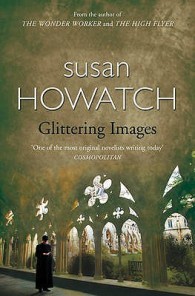Book Reviews: A Question of Integrity and Glittering Images
Posted on: April 2, 2018
Susan Howatch, A Question of Integrity, London: Warner Books, 1997, 680 pp.
Susan Howatch, Glittering Images, London: Harper, 1987, 504 pp.
 These novels were a gift from a church member, who shared that they were her favorite books. She prayed for me diligently during my treatment, and often at St. Marylebone Parish Church, whose healing ministry provided the inspiration for one of the churches in the stories. I didn’t get a chance to read them during treatment, so I am catching up.
These novels were a gift from a church member, who shared that they were her favorite books. She prayed for me diligently during my treatment, and often at St. Marylebone Parish Church, whose healing ministry provided the inspiration for one of the churches in the stories. I didn’t get a chance to read them during treatment, so I am catching up.
Glittering Images is the first in the five-volume Starbridge series, and A Question of Integrity is the first in the St. Benet’s Trilogy. I read them back-to-back, and they were similar enough for me to decide to write one review instead of two. Both novels feature lead characters who are male clergy in the Church of England with have strong intuitive, if not psychic, powers that they deploy in their ministry. The stories explore how these powers work for good in their healing work and even exorcisms, but the bulk of the plot in both books comes from the clergy’s more sinister desires, especially around sex. Glittering Images uses the metaphor of a public “glittering image” that masks a true self mired in desire, unfulfilled longing, and wounds of old relationships with family and lovers. A large part of the content of both books consists of conversations and monologues with the main characters (clergy and non-clergy) baring their souls to one another or a spiritual director, narrating therapy sessions where they construct a catalogue of their desires, sins and secrets.
 Glittering Images is set around the fictional Starbridge Cathedral and surrounding area, in the late 1930s. Scholar-priest Charles Ashworth is sent as a spy by the Archbishop of Canterbury to discover any improprieties in the living arrangements of the Starbridge bishop, Jardine, who shared his home with both his wife and her female companion. Ashworth and Jardine become entangled with one another’s secrets, lovers and desires as they both must confront their twisted interior lives against the respectable public personae.
Glittering Images is set around the fictional Starbridge Cathedral and surrounding area, in the late 1930s. Scholar-priest Charles Ashworth is sent as a spy by the Archbishop of Canterbury to discover any improprieties in the living arrangements of the Starbridge bishop, Jardine, who shared his home with both his wife and her female companion. Ashworth and Jardine become entangled with one another’s secrets, lovers and desires as they both must confront their twisted interior lives against the respectable public personae.
A Question of Integrity takes place in the late 1980s in London, in a fictional parish whose healing centre is modeled on St. Marylebone Parish. Descendants of the characters from Starbridge appear as well. There are five main characters: Alice, a young woman in crisis attended by the healing ministry, who joins the staff and becomes a healing presence to all; Lewis, a cantakerous older priest with a dodgy past trying to live a pure and celibate life and use his psychic powers for good; Nicholas Darrow, a dashing superstar healer with enormous powers and a dangerously inflated sense of his own moral compass; Rosalind Darrow, his wife who seeks her own way apart from him; and Stacy, a young curate trying to sort out his own identity and missing his family. The narrative is told it five sections, with each character narrating one in first person (except Stacy, Alice gets two), each battling with their own sexual desires.
I was intrigued enough by the first book to immediately read the other one, but I am doubtful if I will continue with either series anytime soon. I think the stories attempt to portray the lives of the clergy in a way that humanizes them, but in the end made them seem extreme in both their gifts and their sins, which makes them even larger than life. Also absent are the lives of women in ministry, who always draw my interest far more strongly. The clergy in the stories are all redeemed in the end by their efforts at honesty, self-disclosure and truth-telling.
4 Responses to "Book Reviews: A Question of Integrity and Glittering Images"
I’m curious whether “dodgy,” a word we all know, to describe the cantankerous priest is an English usage you’ve been drawn to or one you’d have been as likely to apply before London? I’ve always enjoyed adopting local usages I’ve liked in places we’ve lived. And, Happy Easter!
>



April 2, 2018 at 6:46 am
Devoured Susan Howatch books back in the nineties. Found them to be very Jungian and thought provoking, as well as good, captivating prose. The Church of England series was my favorite. The later ones seemed more far-fetched, but still very readable.
April 2, 2018 at 12:07 pm
Interesting. I found myself thinking as I read them that they would have been far more provocative and fresh when they were written 20 years ago.